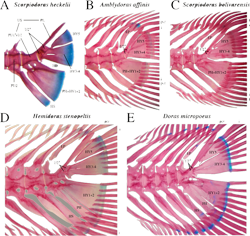|
Phylogenetic reorganization of Cyprinodontiform fishes "Within the Cyprinodontiforms, fusion of the hypural plates into a so-called hypural fan (following the terminology of Rosen, 1964) occurs within several monophyletic groups of genera (e.g., fig. 2F). There is just one epural which mirrors in shape and position the autogenous parhypural. There are no separate ural centra. The hypochordal musculature is also absent (Rosen, 1964). This formation of a symmetrical caudal fin in unique among teleost fishes." (Emph. mine - RJS) |
|
Evolution's Mirror in a Fish's Spines "Kingsley and his colleagues found such an animal in the threespine stickleback fish. These small fish typically live in the ocean but breed in coastal streams. After the last ice age ended some 11,000 years ago, populations of sticklebacks rapidly colonized newly formed freshwater streams and lakes - through a process known as adaptive radiation. The many stickleback populations underwent disparate and parallel evolutionary changes, among them partial or complete loss of their pelvic spines. These spines are thought to protect the fish from being devoured by predators. As Kingsley points out, however, pelvic spines may be a disadvantage if the fish live in environments that have very low calcium levels available for building the skeletal structures, or in locations with many large predatory insects that hunt sticklebacks by grabbing hold of the spines. “Although vastly different morphologies have evolved in different stickleback populations, they have evolved recently enough that you can still take those different populations, cross them and actually let the genetics of the trait guide you to the underlying events that have controlled the process,” said Kingsley." |
|
The caudal skeleton of extant and fossil cyprinodontiform fishes (Teleostei: Atherinomorpha): comparative morphology and delimitation of phylogenetic characters The caudal skeleton of teleost fishes of the order Cyprinodontiformes is described and compared on the basis of 394 extant and eight fossil species, supporting delimitation of 21 phylogenetic characters, of which 13 are firstly reported. The Cyprinodontiformes are unambiguously diagnosed by the presence of a single, blade-like epural, and by principal caudal-fin rays continuous on upper and lower hypural plates. Monophyly of the suborder Cyprinodontoidei is supported by the widened neural and hemal spines of the preural centrum 3 and presence of a spine-like process on the stegural, and monophyly of the Aplocheiloidei by the absence of radial caudal cartilages. A keel-shaped lateral process on the compound centrum supports monophyly of the Nothobranchiidae. Some characters of the caudal skeleton in combination to other osteological features indicate the cyprinodontiform fossil genus †Prolebias to be a paraphyletic assemblage; †P. aymardi, †P. delphinensis and †P. stenoura, the type species of the genus, all from the Lower Oligocene of Europe, possibly are closely related to recent valenciids; †“P.” meridionalis from the Upper Oligocene of France is an incertae sedis cyprinodontid; and, †“P”. cephalotes, †“P”. egeranus and †“P”. malzi from the Upper Oligocene-Lower Miocene of Europe are closely related to poeciliids, probably closely related to the recent African genus Pantanodon due to they sharing unique derived features of pelvic fin, branchial arches and jaws. |
|
Towards a complete classification of the Neotropical thorny catfishes (Siluriformes: Doradidae) Mark Henry Sabaj
and Mariangeles Arce H.
|
|
Development of the caudal-fin skeleton reveals multiple convergent fusions within Atherinomorpha Abstract |
|
African cichlid fishes: morphological data and
taxonomic insights from a genus-level survey of
supraneurals, pterygiophores, and vertebral
counts (Ovalentaria, Blenniiformes, Cichlidae,
Pseudocrenilabrinae)
Here, I provide the first survey in cichlids of the considerable variation in numbers of vertebrae, supraneurals and dorsal- and anal-fin supports (pterygiophores), as well as the patterns with which the pterygiophores insert between the neural or haemal spines. The study includes some 1700 specimens of nearly 400 cichlid species. Focusing on the largest subfamily, the African cichlids or Pseudocrenilabrinae, the survey furnishes data from species in all but one of its 166 genera. Limited data from species in the other cichlid subfamilies (Etroplinae, Ptychochrominae and Cichlinae) and from the related leaffishes, Polycentridae, are also presented. Key examples of pterygiophore insertion patterns from throughout the range of variation are illustrated and discussed. Detailed analytical tables and all raw data are provided in supplementary files. A bizarre specialisation in Cyprichromis is noted, evidently for the first time. Uniquely in this Lake Tanganyikan genus, five to seven anal pterygiophores are abdominal in position, located anterior to the anal fin and inserting toward or between successive pairs of pleural ribs. Taxonomic changes: The most speciose tribe of African cichlids, currently known as Haplochromini, is correctly called Pseudocrenilabrini. Based chiefly on the molecular phylogenetic findings of other workers, I propose four pseudocrenilabrine subtribes, one occurring in rivers and three endemic to Lake Malawi. I also re-assign the Lake Tanganyikan tribe Tropheini as another subtribe of Pseudocrenilabrini, in line with numerous molecular studies placing tropheines firmly within this tribe. The remaining genera of Pseudocrenilabrini remain incertae sedis in this tribe pending clarification of their phylogenetic relationships. The character complex here surveyed is a promising source of taxonomically and phylogenetically informative characteristics distinguishing or uniting cichlid taxa at multiple hierarchical levels, from species through subfamily. This reference set of novel character data can also provide information for palaeontological studies of African cichlids. These attributes are skeletal features potentially available for study in well preserved fossils and may help determine their correct taxonomic placement. |

